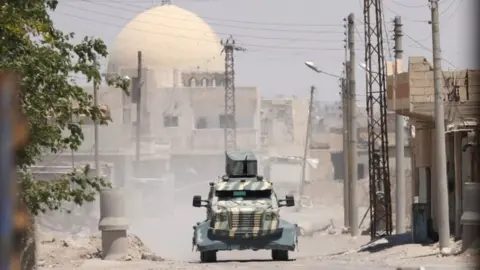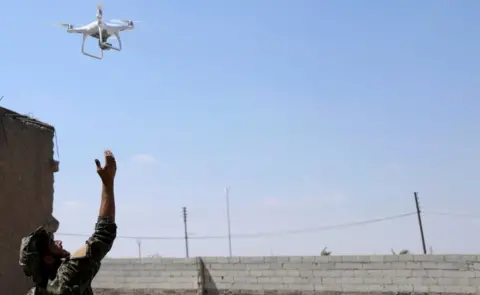Trump and the battle for eastern Syria
 Reuters
ReutersThe battle for Mosul may be entering its final phase. The battle for Raqqa is under way. But the battle for the future of eastern Syria is just beginning.
This is where the parallel struggles - on the one hand the US-led coalition against so-called Islamic State (IS), and on the other the Assad regime and Iran against a variety of US-backed Kurdish and rebel groups - meet head on.
All of the bitterness and complexity of the Syrian conflict is here and with IS increasingly on the back foot - at least in terms of its organised hold on territory - this is where the strategic stakes are growing day by day.
This is also where the US risks being drawn ever closer into the Syrian conflict - as the shooting-down of a Syrian warplane that was reportedly bombing US-backed forces near Tabqa, south-west of Raqqa, shows.
This is the fourth incident in almost as many weeks where the US has taken military action against elements loyal to the Assad government.
Previous incidents were far to the south, near al-Tanf, close to the Syrian border with Iraq, where Iranian-backed allies of President Bashar al-Assad approached a US-designated exclusion zone, within which US troops train and advise rebel forces.
The US has presented these actions as being legitimate tactical responses to potential threats to its personnel, or in this latest case "in collective self-defense of coalition-partnered forces". But these "tactical" actions cumulatively risk a step-change in US involvement at a time when many critics of the Trump administration say that it is lacking any over-arching strategy in Syria.
Indeed President Donald Trump's willingness to give the Pentagon more leeway in responding to such potential threats only serves to increase the likelihood that such encounters will happen more frequently.
There are fears that what strategy the US has - and there are powerful voices in the White House urging further steps to counter Iranian influence in the region - could precipitate a range of unwanted consequences.

This, after all, is one of the key factors in the Trump administration's backing of Saudi Arabia's efforts to ostracise Qatar, even though the US maintains its key air base and command centre in the region there.
In eastern Syria - specifically in the area near the border with Iraq - US forces have struck Iranian-backed fighters, sending a wider signal that will clearly be heard in Tehran.
The fault is by no means all Washington's. It may lack a strategy but it is responding to immediate tactical concerns.
Iran is pushing at the envelope and its timing is no accident. Iranian advisers and Iranian-backed militia groups, not least Hezbollah, provide a crucial element of President Assad's fighting strength.
With IS up against it, a race is on to see who will dominate the territory it vacates.
 Reuters
ReutersIran, already a major influence in Iraq, is eager to consolidate and extend its influence inside Syria. Some analysts have speculated that it would like to establish a "land bridge" between Damascus and Baghdad that would enable the movement of arms and materiel to its allies in Lebanon.
But whatever the motivation, Iran clearly intends to capitalise on its support for the Assad regime to achieve lasting influence in Syria.
This struggle is also increasing tensions between Washington and Moscow. The Russian ministry of defence's statement in the wake of the shooting down of the Syrian warplane contains much of the usual rhetoric - the charge that the US is violating Syrian sovereignty and breaking international law.
But Moscow has also suspended the co-ordination channel set up to avoid clashes between US and Russian forces.
The statement carried a threat too - namely that in areas where Russian aircraft are operating, coalition drones and aircraft west of the Euphrates river will be tracked and "treated as targets".
It should be noted that the co-ordination mechanism has generally worked well and its operation is as much in Moscow's as Washington's interest. A previous "suspension" of the mechanism by Russia seems to have been by word only - behind the scenes contacts continued.
But as the battle for eastern Syria steps up, Russia and its Syrian government ally seem intent on drawing a line in the sky, just as President Assad's ally Iran seeks to draw new lines on the ground.
